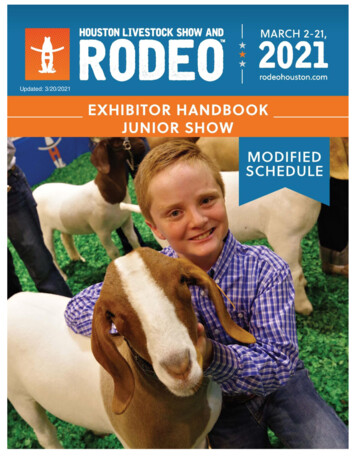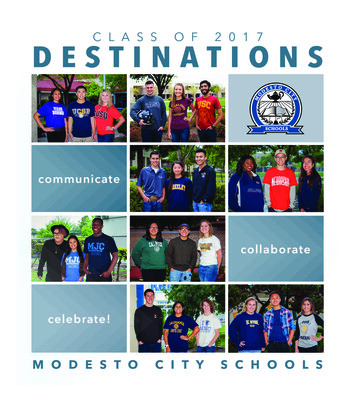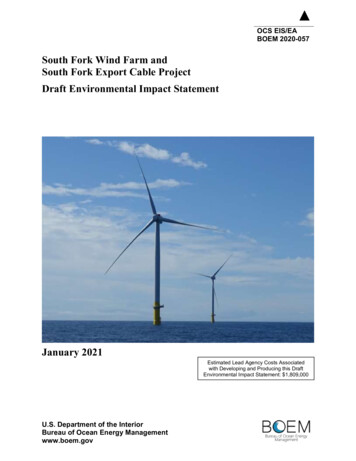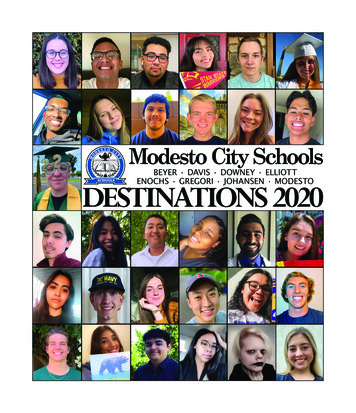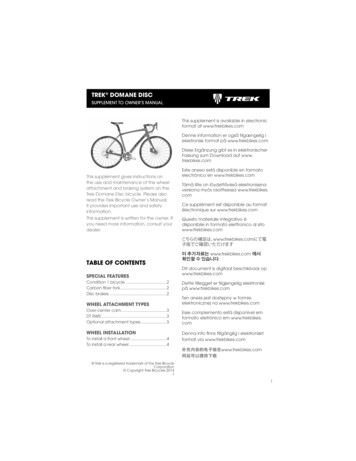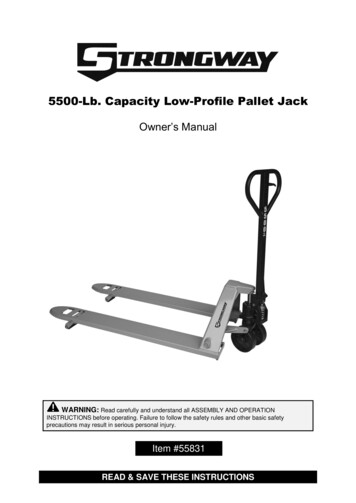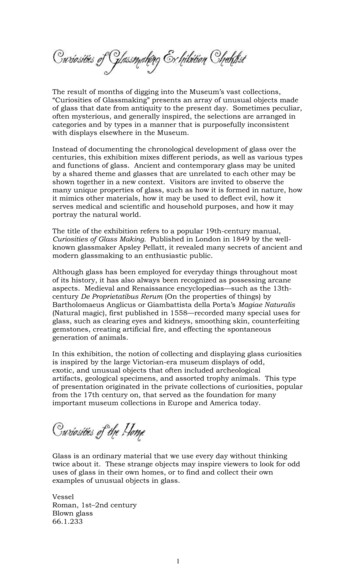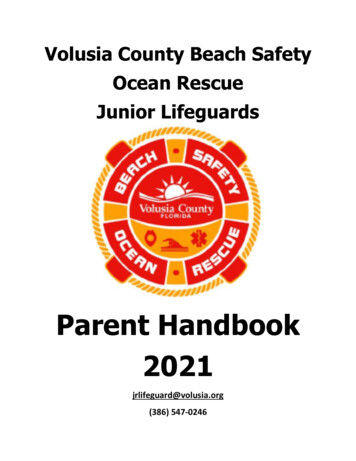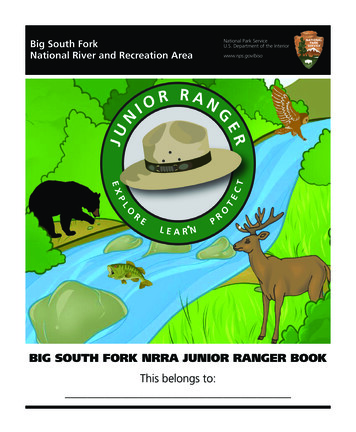
Transcription
Big South ForkNational River and Recreation AreaNational Park ServiceU.S. Department of the Interiorwww.nps.gov/bisoBIG SOUTH FORK NRRA JUNIOR RANGER BOOKThis belongs to:
To become a Junior Ranger, complete the following activities.1. Children ages 6 and younger must complete at least 6 activity pages withOscar the Otter in the corner.2. Ages 7 and older must complete at least 6 pages with Oscar the Otterin the corner and 6 additional activity pages.3. Visit the Bandy Creek or Stearns Visitor Center or the Blue HeronMining Camp and stamp your book in the circle below.4. After finishing your Junior Ranger book bring it back to a visitorcenter to be checked.5. Upon completing all the requirements, you will receiveJunior Ranger certificate and badge making you an official Big SouthFork Junior Ranger.a6. On weekends (Memorial Day through Labor Day) talks, walks andother programs are offered in the park. You should attend one of these andget a park ranger to sign your book.I,,pledge to be a good Junior Ranger,to learn about Big South ForkNational River and RecreationArea and to protect the park fromharm. I will help others have funlearning about the park, the BigSouth Fork River,the park’s history and about all thenatural resources protectedwithin the park. I will do mypart to obey the rules ofthe park and alwaysact in a safemanner.2PARK RANGER SIGNATUREDate your book with the EasternNational Passport Stampat one of our visitor centers.
Safety First!Oscar says Be safe aroundThe Big South Fork is a free flowing river. You can canoe, raft, fish or swim in the river, but there arecertain things you must do to be safe. A “PFD” is a personal flotation device. You may know it as a“life jacket”.Color the picture of Oscar floating on his back wearinghis PFD. Make his life jacket orange or yellow.You “otter” do these things:Fill in the blanks from the words in the box. Learn how to . Always swim with a . Wear a jacket when you are in a oraround rivers or ponds. Obey the at the swimming pool and listen tothe life guards. Throw something that will to someone that isin trouble. Never jump in to help them! Know how to dial for help.boatfloatlifeswim911buddyrules3
On the trailGood choices lead to a successful finish.You may encounter many different situations along the trail. Circle the things you should do toobey park rules.Carry out all of my trashTalk loudlyPick a flowerKeep my dog on a leashStay with my groupTake a shortcutRun aheadFollow the trail markersLet my dog chase a deerTake a picture of a flowerLeave food for the animalsListen for nature soundsTrail ChecklistAlways take these things in your backpackif you are hiking, biking or riding your horse.Why should you tell an adult where you are going?Why should you drink water and not a cola?What color of rain jackets are easier to see in the woods?Why should you not just yell “HELP?”Why should you not eat berries you find along the trail?Be prepared to talk with the ranger about why you need these in your pack.Take Only Pictures and Leave Only FootprintsPark visitors should never pick up or collectanything to take home with them. You canremember your visit by taking pictures of thethings you see. Draw a picture in the cameraviewer below of something that you saw at BigSouth Fork National River and Recreation Area.Help keep the park beautiful!Pick up trash at your campsite and along trails.Leave only your footprints behind.4
Take a hike in the Big South ForkMake a list of trails that you hiked or places that you visited.If you get lost, you should “Hug a Tree.” It helps you stay in one place!In the box below, draw a picture of you hugging a tree.Draw the shape of your tree’sleaves in the box below.What kind of tree is it?What does the bark feel like?Decoding the Big South ForkLearn Oscar’s secret to staying safe on the trail.A16B12C7D21E24F3G5H1I9J14N 10 O4 P8Q11R25S19T 15 U22V13W64 19 7 16 256 1 24 1010 24 13 24 251 9 26 9 10 55 4 24 191615 25 16 9 1815 1 2412 18 16 20 24 196 16 10 21 24 25 194 3 316 10 219 3X2L18Y17M 23 Z 20 16 18 4 10 243 4 18 18 4 6 1915 25 24 24K2616 18 6 16 17 1910 24 13 24 251 22 5 191618 4 19 155
As a Junior Ranger you can help the park.Rangers help protect the park wildlife, plants, rock features, historic places and the peoplewho visit here. Some things that people do are not allowed in the park and are against therules. As a Junior Ranger you should always follow the rules.Circle the things in this picture that visitors aredoing wrong and list them below.1.2.3.4.5.6.7.6Put a check on the things that the visitors aredoing right. What are they?1.2.3.4.
Let’s Do LunchDid you know that animals that eat only plants are called herbivores? Meat eaters are calledcarnivores. Animals that eat both plants and meat are called omnivores.Help these animals select an item from the menu. Write the number of the item from themenu on the plate beside each animal.What would you pack for a picnic lunch? Write down your lunch on line #6 below and drawa picture of it on the plate.Little Brown BatGray SquirrelRaccoonMENU1. A medley of ripe acorns, shelled walnuts andhickory nuts served on a bed of fresh beechnuts.Red-tailedHawk2. Fresh stew with field mice, voles, and rabbitsseasoned with various snake types.3. A stir fry of cucumber beetles, green stinkbugs, June bugs, and leafhoppers garnished witha few moths.4. Large house salad with twigs, buds, nuts, fruit,corn, grubs, and ants tossed with fresh sprouts,served on a tray of rotten log with a yummy honeydressing. In season: Left-over carrion (deadanimals).5. Boiled crayfish, frog, and turtle eggs with a sidesalad of mixed berries, nuts and grapes.6.your picture6.your nameBlack BearDescribe your picnic lunch.7
Big South Fork Word SearchCan you find the names of interesting places to see andthings to do at Big South QAngel FallsCharit Creek LodgeMountain LaurelBandy CreekCumberland PlateauRaftingBig Leaf MagnoliaDeerRhododendron8Big South Fork Devils JumpRiverBlack Bear FishingScenic Railway Black Rat Snake Horseback RidingTennessee Blue Heron Kayaking Trail Box TurtleKentucky Twin Arches Canoeing Maudes Crack Wild Turkey
Horse PlayHorses and mules played an important rolein the area. Historically these animals wereused to move lumber, coal, rock and clearland for farming. Circuit preachers, schoolteachers, mail carriers, country doctors andmidwives traveled the mountainous terrainto remote homesteads and communities.Horseback riding is one way to see Big SouthFork today. Here is a horse for you to color.You may want to copy this page later andcut out the tack to dress your horse.Give your horse a name .What color is your horse?Where will you ride at Big South Fork? List aname of a horse trail that you’d like to ride.Look at a horse trail map to find the trailname.What does a horse wear? Can you list thedifferent pieces of horse tack (equipmentused on a horse) that are in the picture?1.2.3.4.5.6.Look at the picture. What kind of thingsshould you take with you in your saddlebags?1.2.3.4.5.6.7.9
Animal TracksCan you identify animals that live in the Big South Fork fromtheir tracks? Draw a line from the animal to its track.Great Horned OwlWhitetail DeerRaccoonGrey FoxGreat Blue heronBlack bearBobcatSkunkWildlife SafetyCircle the correct answer or answers.There may be more than one that iscorrect.You should not try to pet a baby wild animalbecause(a) It might be sick.(b) It might bite you.(c) An angry mother might be watching you.(d) It might follow you and become your pet.If you are bitten by a snake(a) cut the bite and suck the venom out(b) seek medical help(c) tie a rope or piece of cloth very tightly abovethe bite.If you see a fawn laying in a grassy field(a) Pick it up and take it to a ranger.(b) Leave it alone because its mother is nearby.(c) Take it to the zoo.If you camp in the backcountryIf you see a black bear(a) hang your food high out on a tree limb(a) Run away as fast as you can.(b) leave your leftovers for the animals to eat(b) Stand tall, wave your arms and yell “No Bear!”(c) pack out everything that you took with you.(c) Throw your food at it.If you see a snake on the trail(a) Kill it.(b) Take a stick and move it off of the trail.(c) Back up and walk another way.10If you see a wild baby piglet(a) back up, be very still and quiet until it walksaway(b) throw sticks and try to make it squeal(c) try to catch it.
Jr. Ranger Storytelling PageEveryone loves a good story. In the past, stories were the way people remembered thingsthat had happened and the way people passed along their history to others. Today,people still tell stories, sometimes just for fun and sometimes to tell others about thingsthat have happened.Here is a story about Big South Fork.The Story of How Devil’s Jump Got Its NameIn the early 1900s loggers began cutting the large trees along the Big South ForkRiver. The trees were dragged to the river and chained together to make log raftsto be floated downstream to sawmills.The men who guided these rafts down the river were called raft devils. Most ofthe river was calm and smooth, and the raft devils had no problem riding alongon the log rafts. But there was one spot on the river that had tall cliffs on bothsides and boulders as big as houses in the middle of the river. At this spot thewater became very fast and formed a large dangerous rapid. To avoid the swift,dangerous water the raft devils would jump onto the big rocks and let the logsfloat through on their own. Because of this, the rapid became known as Devil’sJump. That name is still used to this day.Use the space below to write a story about you and your family and youradventures in Big South Fork.11
Welcome to Blue HeronA trip to the Blue Heron Mining Community, either byriding in on the Scenic Railway or driving by car, is agreat way to spend a day. Blue Heron allows visitorsto view life in a company-owned mining town in the1940s and 50s. As you walk through the communityof Blue Heron, or Mine 18 as it was also called,study the exhibits and answer the questions in thescavenger hunt. If you do get stumped, you can askone of the park rangers for help.The SchoolhouseCourtship,Marriage andFamilyAs you leave the depot,take the paved path leftup the hillside to thehouse which talks aboutcourtship, marriage andfamily. Stop there andlisten to the narration.One of the men talksabout being marriedwearing a hickory-stripedsuit. Why would a suitgo by that name?12The Mine EntranceLook at the machinery and read the signbeside the coal mine entrance.Find the Joy Loader. How did this pieceof machinery change the way coal wasprocessed from the Blue Heron Mine?How did the Joy Loader affect the wayminers were paid?The year is 1944 and yourdad is a coal miner workingat Mine 18. Your familylives in a company houseperched on a hillside abovethe Big South Fork River.Every morning after youdo your chores you attendschool down in Blue Heron.Each morning you andalmost twenty otherstudents arrive at the littleschoolhouse.Some of the students areolder and some youngerthan you since gradesthrough arein that one schoolhouse.You like school and hopeto go to high school andcollege.
Bandy Creek Scavenger HuntWhere can a you get a map of Big South Fork?Find the plaque that dedicated the Bandy Creek Campground.Write down the date.How many campsites are in Area A?Draw a picture of yourself here.How many horse stalls are at the Bandy Creek Stables?Find a tree that has star shaped leaves. What is the name ofthis tree?Name an animal on display in the Bandy Creek Visitor Center.How long is the trail from Bandy Creek to Blue Heron MiningCommunity ?How deep is the Bandy Creek pool?Find a tree that has needles instead of leaves. Write down thename of the tree you found.Draw a picture of the needles.Find the track of an animal. What animal would make thistype of track?Find a park ranger and ask them to let you look at theNational Park Service arrowhead emblem. Describe what yousee in this emblem. Draw a picture of it inside the arrowhead.The arrowhead is the symbol of the National Park Service. It stands for the way that parksprotect plants, animals, scenery and human history all across the United States.13
Big South Fork Rocks!The Big South Fork of the Cumberland Riverruns north through the Cumberland Plateau. Itflows out of Tennessee into Kentucky where itbecomes part of the Cumberland River. Overmillions of years the river has carved a gorgeinto the rocks of the plateau more than500 feet deep. The rocks that make up theCumberland Plateau were all deposited by waterlong, long ago. This type of rock is knownas sedimentary rock. The sedimentaryrock here is stacked one layer on top ofanother just like the layers in a cake.The most common type of rockin the park is sandstone. It is therock which makes up the cliffs,arches, rockshelters and boulders.Sandstone is made of grains ofsand and sometimes small pebbles.Sandstone that contains a lot ofpebbles is called conglomerate.Under the coal, limestone is found. It is made upof the shells of ancient sea creatures. Sometimesfossils of this ancient sea life can be found inthe limestone. Most of thelimestone is still below theground and can only be seenin a few places.Beneath the sandstone is a layerof soft gray rock formed from claycalled shale.Layers of coal can be found belowthe shale. Coal is made of theremains of ancient plants that havebeen turned into a black rock whichactually burns! Coal is still mined in someplaces on the Cumberland Plateau. Coal wasonce mined in what is now Big South Fork. Visitthe Blue Heron Mining Community in Kentuckyto learn more about coal mining.Unscramble the letters for the namesof these types of rock. Then, placethe rock layers in their proper orderby using the information above.ahlesaclomesoetnlidenntsosa1234Here are some trails where you can really see the rocks of theBig South Fork.The Angel Falls TrailThe Twin Arches TrailThe Blue Heron Loop TrailThe Yahoo Falls TrailPlease remember that all plants, animals and rocks in Big SouthFork are protected. You may not take them from the park.14
Keeping It Clean and GreenOne of the easiest things to do to help your park is to pick up litter.It’s safest to do this wearing gloves and using a pick up tool or areacher. Put each piece of trash in a box or garbage bag,then recycle or throw away when you’re done.The recycle bins at Big South Fork NRRA are bright blue withlabels for plastic, glass, and aluminum. Circle the items thatcan be recycled below:15
Dated thisPark Ranger Signatureday ofBig South Fork National River & Recreation AreaJunior Ranger Activity Bookletfor completing theplease print nameThis certificate is proudly presented to
to learn about Big South Fork National River and Recreation Area and to protect the park from harm. I will help others have fun learning about the park, the Big South Fork River, the park's history and about all the natural resources protected within the park. I will do my part to obey the rules of the park and always act in a safe manner. 1.
